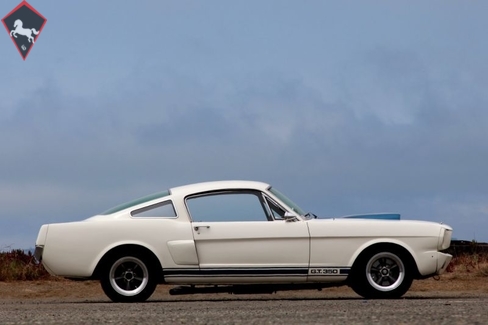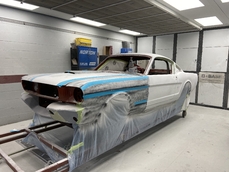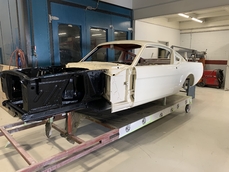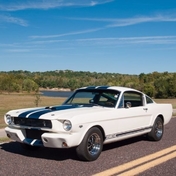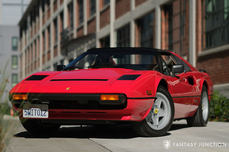Shelby GT 350 289 c.i. V-8 1966
Allgemeine Beschreibung :
This car is currently not at Fantasy Junction but can be viewed by appointment1966 Shelby American GT350
s/n SFM 6S342
White with Black Interior
Nothing says American performance like Carroll Shelby. With his legendary Cobra, LeMans winning bravado, and Texas homespun charm, Ford knew they could count on ol’ Shel to deliver a genuinely high performance race ready variant of the already successful Mustang. The production GT350 was fast, loud and exhilarating to drive, a uniquely brawny American GT that was a match for almost any other machine on the road. But the production GT350 was a carefully planned compromise, a streetable allowance toward the car Shelby intended to race – the GT350R, the “R” signifying its racing specification.
The production GT350 suspension, steering and brakes were already outfitted for SCCA competition, but the R-model’s K-code 289 powerplant needed work. R-model engines were built to order, using blueprinting, heads ported and polished by Valley Head Service, Tri-Y headers by Cyclone, a center-pivot-float Holley 715 CFM carburetor on a Cobra intake and flow-through side-exit exhaust. Outputs ranged from 325 to 360 horsepower on the Shelby dynamometer. Differential and engine oil coolers were added, the latter necessitating the distinctive fiberglass front valence that distinguished the R-model. Plexiglas replaced the R-model’s side and back windows, the fenders were flared to accommodate wider Goodyear racing tires; a four-point roll bar was welded in and a quick-fill 37-gallon fuel tank was installed in the trunk. The GT350R was the full realization of Shelby’s plan for a racing Mustang, and it immediately dominated SCCA B-Production racing.
The GT350R instantly became the template for racers hoping to emulate Shelby’s winning formula but unable to buy one of the 34 built by Shelby American. In 1966 Shelby knocked some of the rough edges off the production GT350, requiring more work to convert the street version to so-called “R spec” configuration. Still, independent competition GT350s proliferated, a few even springing up across the ocean in Britain and Europe. One of the most interesting of these is our featured offering, a 1966 GT350 owned and raced by Swiss ace driver Herbert Müller from 1966 through the early 1970s. This GT-350 started life as a European export model shipped to Ford Advanced Vehicles in Slough, England. Once in the UK it was modified with R-Model type racing equipment including a roll bar, oil cooler, 37-gallon fuel tank, fiberglass front valence, and American Racing Torque Thrust “D” alloy wheels. The icing on the cake however was the amazing engine; aWeber-inducted GT40 engine built by Holman-Moody.
The cherubic, friendly Müller was the kind of fearless racer to whom the GT350 had instant appeal. Müller had become one of the most experienced and accomplished drivers in the world of sports and prototype racing by the time of his tragic death at the 1981 Nurburgring. He began his career in 1959 racing motorcycles and advancing to European hill climbs. Driving a series of Porsche GT racers, he became especially successful in the FIA European Hill climb Championship, winning the GT Championship in 1963. While his speed and grace behind the wheel was opening doors into international GT and endurance racing with Porsche, Ferrari and Ford, Müller also kept his hand in hill climbing, often taking his son to weekend events in his 1966 GT350.
After his passing, Müller’s personal car collection sat dormant until 1985, when Ron Randolph, a civil engineer with the Army Corps of Engineers in Frankfurt and an accomplished restorer of vintage sports cars, learned of the Müller GT350 through exotic car dealer Auto Exclusive of Zurich, Switzerland, whom Müller’s son had asked to broker its sale. First Randolph had to convince the young man that he would properly care for the car. Randolph later recounted the occasion: “When I told him I planned to restore it completely, take good care of it and race it in historic events in Europe, he thought it over, then reluctantly decided to sell it. He had an attachment to the car because his father took him to races in it, and then raced it, and then they would return home in it. Those were the days when you could drive your racecar to the track. So the car was part of the family. But Müller’s son obviously liked the idea of the car returning to racing instead of sitting around in the garage.”
After years of storage the car remained solid but needed to be completely rebuilt, a task that took Randolph and his friend Rich Bard over 600 hours to complete. They stripped it down to bare metal, repainting it in the original Wimbledon White with Guards Blue stripes before rebuilding the entire car. Randolph: “We worked in the (USAFB) Rheine-Main Auto Craft Shop right from the beginning, where we disassembled most of the car, went down to bare metal on the underbody, stripped off all the old paint – everything. I rebuilt the engine, reworked the body where necessary, along with the suspension, brakes and everything else. We also sanded the body down for painting; it’s a complete restoration job.”
Randolph completed the car in time for the August 1986 Nurburgring Historic race. Electrical gremlins kept it from lapping the storied German circuit on that first outing, but Randolph subsequently raced the car regularly before displaying it at the Nurburgring Race Car Museum and then lending it to Peter Kaus’ famous Rosso Bianco Collection in Aschaffenburg, Germany, in 1988. It remained there for 18 years before Randolph once again assumed its care and maintenance.
Shelby serial number SFM6S342, the Müller GT350 remains configured as it was when delivered by Ford Advanced Vehicles, retaining the Holman-Moody-built GT40 engine. It is best described as having an honest, top-tier driver presentation inside and out, and is in outstanding mechanical order. Serial number SFM6S342 is officially listed as an Independent GT350 Racer in the Shelby Registry and is offered with extensive supporting documentation, including contemporary news articles, a copy of the invoice from Shelby American to Ford Advanced Vehicles and a copy of the letter from Auto Exclusive to Ron Randolph confirming the Müller estate’s interest in selling the car.
Recent mechanical work has been performed with all parts sources from Cobra Automotive, including new fuel lines with 4 banjos replaced, driver’s seat replaced (former one retained and included with the spares), front brake calipers rebuilt with new wheel cylinders using Porterfield rear shoes and front pads (former pads in spares), engine mounts replaced, new Tru-Trac posi-differential with new ring and pinion, axle bearings replaced with new seals, and new Optima battery. A nut and bolt “Race Prep” has been done on the car and all systems are operating as expected.
Today SFM6S342 remains as one of the most thoughtfully prepared Shelby Mustangs outfitted with R type features and documented period racing history. Cosmetic condition is very nice overall with suitable racing patina echoing use and preservation consistent with dedicated enthusiast ownership. Paint remains very nice overall with some chips due to road use and good chrome overall. Care has been given to retain proper engine fittings and finishes without compromising use. Interior is in excellent condition, featuring Carroll Shelby glovebox signature, fire extinguisher, and rear seat delete panels. Undercarriage is in very nice condition overall with most finishes as originally specified from the factory, allowing some concessions for modern safety and improved use.
SFM6S342 is offered with a massive documentation binder outlining Müller’s racing exploits (mainly in Porsches), photos of the body restoration process showing excellent structural integrity, documentation from Auto Exclusive in Switzerland regarding the sale in 1985 to Ron Randolph, and newspaper articles outlining the car’s history with Randolph and before. It is also offered with a second set of wheels, and an extra engine block and single head, among other minor yet helpful spares.
With its unique racing history, European and American provenance, and highly desirable Holman-Moody built GT40 engine, this Independent Competition GT350 remains a refined and capable example of Carroll Shelby’s vision for building a competitive American performance car. It is eligible for many prestigious events around the globe, and with its interesting early competition history, will surely enjoy heightened acceptability over standard converted street GT350s.Pricing flexibility exists for offers with a close prior to or during December of 2016.
http://fantasyjunction.com/cars/1573-Shelby-GT350-289%20c.i.%20V-8
1966 Shelby GT 350 289 c.i. V-8 is listed verkauft on ClassicDigest in Emeryville by Fantasy Junction for $265000.
Fakten der Auto
Karosserietyp : Auto Marke : Shelby Modell : GT 350 Ausführung : 289 c.i. V-8 Hubraum : 0.0 Modelljahr : 1966 Lage : Emeryville
Verkauft
Angaben Zum Verkäufer
Verkauft
People who viewed this Shelby GT 350 also viewed similar Shelby listed at ClassicDigest
Other cars listed for sale by this dealer
über Shelby
Carroll Shelby, eine legendäre Figur in der Automobilwelt, hatte einen bemerkenswerten Weg vom erfolgreichen Rennfahrer zum renommierten Sportwagenhersteller in den Vereinigten Staaten. Seine Geschichte ist voller Erfolge, Innovationen und ikonischer Autos, die einen unauslöschlichen Eindruck in der Branche hinterlassen haben.Frühe Jahre und Rennkarriere:
Carroll Shelby wurde 1923 in Texas geboren. Während des Zweiten Weltkriegs verfolgte er zunächst eine Karriere als Pilot, entdeckte aber nach dem Krieg seine wahre Leidenschaft im Rennsport. Shelby wurde in den 1950er Jahren ein erfolgreicher Rennfahrer und nahm an verschiedenen Veranstaltungen teil, darunter der Formel 1, Langstreckenrennen und den berühmten 24 Stunden von Le Mans.
Shelby Cobras – ikonische Sportwagen:
Carroll Shelbys entscheidender Moment als Hersteller kam mit der Entwicklung des Shelby Cobra, einem legendären amerikanischen Sportwagen. Die Cobra entstand aus der Fusion eines britischen AC-Ace-Chassis und eines Ford-V8-Motors und schuf ein leichtes Hochleistungsauto, das sowohl auf der Rennstrecke als auch auf der Straße dominierte. Zu den wichtigsten Modellen gehören:
Shelby Cobra 260 (1962): Die erste Version mit einem 260 Kubikzoll (4,2 l) V8-Motor.
Shelby Cobra 289 (1963–1965): Spätere Versionen mit einem 289-Kubikzoll-V8-Motor (4,7 l), einschließlich der Cobras mit Wettbewerbsspezifikation, die für ihre Rennfähigkeiten bekannt sind.
Shelby Cobra 427 (1965–1967): Die stärkste Version mit einem 427 Kubikzoll (7,0 l) V8-Motor, bekannt für seine rohe Kraft und Leistung.
Ford-Partnerschaft – Shelby Mustangs:
Shelbys Partnerschaft mit Ford führte zur Entwicklung der legendären Shelby Mustangs. Das bemerkenswerteste Modell ist:
Shelby GT350 (1965–1969): Basierend auf dem Ford Mustang wurde der GT350 von Shelby American modifiziert und zeichnete sich durch verbesserte Leistung, Handling und unverwechselbares Design aus.
Weitere bemerkenswerte Modelle und Erfolge:
Neben den Cobras und Mustangs leistete Shelby noch weitere bedeutende Beiträge:
Shelby Daytona Coupé: Dieses Auto wurde für den Sieg gegen Ferrari im internationalen GT-Rennsport entwickelt und war 1965 das erste amerikanische Auto, das die FIA GT-Weltmeisterschaft gewann.
Shelby Series 1: Ende der 1990er Jahre eingeführt, war dies Shelbys moderne Interpretation eines Hochleistungssportwagens.
Der Ford GT40 spielt in Carroll Shelbys Erzählung eine zentrale Rolle, insbesondere in Bezug auf seine Verbindung zu Ford und seinen bedeutenden Beitrag zum Erfolg des Autos.
Die Entwicklung des Ford GT40:
Fords Herausforderung:
Anfang der 1960er Jahre versuchte Henry Ford II, Ferrari zu erwerben, doch die Verhandlungen scheiterten. Dies bestärkte Ford in seiner Entschlossenheit, Ferrari beim prestigeträchtigen Langstreckenrennen 24 Stunden von Le Mans zu schlagen, das Ferrari mehrere Jahre lang dominiert hatte.
Zusammenarbeit mit Shelby:
Ford wandte sich an Carroll Shelby und schätzte dessen Rennsportkompetenz und Erfolgsbilanz. Shelby wurde damit beauftragt, das GT40-Projekt zu leiten und daraus einen konkurrenzfähigen Rennwagen zu machen, der Ferraris Vormachtstellung herausfordern konnte.
Entwicklung und Triumph:
Unter Shelbys Anleitung wurde der Ford GT40 einer gründlichen Entwicklung unterzogen, um anfängliche Designfehler und Leistungsprobleme zu beheben. Es wurden mehrere Iterationen erstellt:
Frühe Versuche: Die ersten Versionen des GT40 hatten Probleme mit der Zuverlässigkeit und dem Handling, was 1964 zu enttäuschenden Ergebnissen in Le Mans führte.
GT40 Mark II: Shelbys Team hat entscheidende Verbesserungen vorgenommen. Der Mark II, ausgestattet mit einem leistungsstarken V8-Motor, verbesserter Aerodynamik und verfeinerter Technik, wurde äußerst konkurrenzfähig.
Le-Mans-Sieg:
1966 errang der Ford GT40 Mark II einen historischen Sieg bei den 24 Stunden von Le Mans, wobei der von Shelby trainierte Fahrer Ken Miles das Rennen anführte. Dies war der erste Sieg eines amerikanischen Herstellers in Le Mans und brach damit die Dominanz von Ferrari.
Anhaltenden Erfolg:
Der GT40 dominierte weiterhin und gewann in den folgenden drei Jahren (1966–1969) Le Mans, sicherte sich seinen Platz in der Renngeschichte und festigte Fords Ruf als Kraft im internationalen Motorsport.
Shelbys Beitrag zum GT40-Erfolg:
Obwohl Carroll Shelby nicht direkt an der Entwicklung des GT40 beteiligt war, trugen seine Erfahrung im Rennsport und seine Fähigkeit, ein Team aus talentierten Ingenieuren, Mechanikern und Fahrern zusammenzustellen und zu leiten, entscheidend zur Verbesserung der Leistung des Autos bei. Sein Einfluss trug dazu bei, technische Probleme anzugehen, das Fahrverhalten des Autos zu verfeinern und Renntaktiken zu entwickeln, was maßgeblich zum Erfolg des GT40 auf der Rennstrecke beitrug.
Vermächtnis und Auswirkungen:
Die Siege des Ford GT40 in Le Mans unter Shelbys Führung gehören nach wie vor zu den ikonischsten Errungenschaften in der Geschichte des Motorsports. Der Erfolg des Autos festigte Shelbys Ruf als Automobilvisionär und stärkte seine Partnerschaft mit Ford weiter.
Carroll Shelbys Beteiligung am GT40-Projekt stellte seine Fähigkeit unter Beweis, ein schwieriges Projekt in eine Maschine zu verwandeln, die die Meisterschaft gewann, und fügte seiner illustren Karriere in der Automobilwelt ein weiteres bemerkenswertes Kapitel hinzu.
